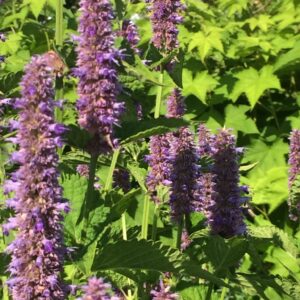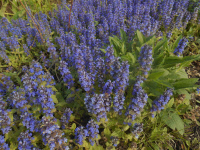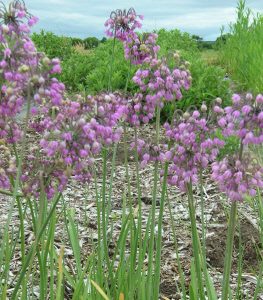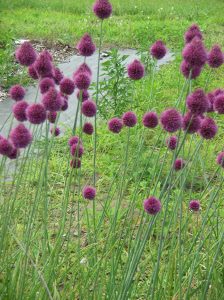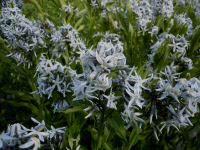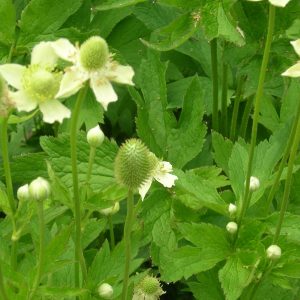Deer Resistant Plants
Showing 9–16 of 155 results
-
Agastache foeniculum Anise hyssop Z 4-8
Purplish-blue spikes from July to October. Fragrant foliage.
Purplish-blue spikes from July to October. Fragrant foliage.
Size: 2-3' x 12"
Care: Full sun in well-drained soil, heat and drought tolerant.
Native: North America, Wisconsin native.
Wildlife Value: Skipper butterflies and Rusty patched Bumble Bees love Anise hyssop’s nectar, deer resistant.The name Agastache is from Greek agan and stachys meaning much like an ear of wheat referring to the shape of the flower spike. Anise hyssop leaves were used by American Americans of the Missouri River region to make tea and as a sweetener in cooking. For Cheyenne it relieved chest pain due to coughing or to a dispirited heart. Listed as an aromatic herb in McMahon’s 1805 book.
-
Ajuga genevensis Geneva Bugle Z 4-9
True blue 6” spikes in spring and early summer
Ajuga genevensis Geneva Bugle Z 4-9
True blue 6” spikes in spring and early summer. Great groundcover.Size: 6” x 12”
Care: full sun to shade in well-drained to moist well-drained soil
Native: Europe
Wildlife Value: Tolerates foot traffic. Deer and rabbit resistant.William Robinson, father of the mixed perennial garden, called this “among the best.” (1933). In gardens before 1753.
-
Allium cernuum Nodding onion, Prairie onion Z 4-8
Umbels of arching stems with nodding bells of lilac shading to pink
Umbels of arching stems with nodding bells of lilac shading to pink or occasionally white. May to June.
Size: 12”-18”x 3-6”
Care: sun to part shade in moist well-drained soil
Native: Canada to Mexico, Wisconsin native
Wildlife Value: nectar source for Hairstreak butterfly, Attracts hummingbirds.Cernuum is Latin meaning “nodding.” Many groups of 1st Americans ate the bulbs raw, roasted or dried for winter storage or as flavoring for soups and gravies. Cherokee used this plant medicinally to cure colds, hives, colic, “gravel & dropsy,” liver ailments, sore throats, “phthisic,” and feet in “nervous fever.” Those in the Isleta Pueblo were not quite as creative as the Cherokee and used this only for sore throats and infections. Meriwether Lewis collected this in Montana and wrote, “I met with great quantities of a small onion about the size of a musquit ball … They were crisp, white and well-flavoured. I gathered about a half a bushel of them before the crew arrivd.” Chicago is believed to be named for the Algonquin word for this plant chigagou.
-
Allium senescens Corkscrew allium, German garlic, Greater mountain garlic Z 4-9
Lavender balls, up to 30 of them, atop thin, bluish, strap-like, twisting foliage – mid-summer day’s dream.
Lavender balls, up to 30 of them, atop thin, bluish, strap-like, twisting foliage – mid-summer day’s dream.
Size: 6-12” x 6-12”
Care: sun to part shade in well-drained to moist well-drained soil
Native: Siberia
Wildlife Value: attracts butterflies & bees, deer & rabbit resistantCultivated before 1753. According to Philip Miller’s 1768 Dictionary, “planted in gardens for the variety of their flowers.”
-
Allium sphaerocephalon Drumstick allium Z 4-11
Claret colored, egg shaped flower heads
Claret colored, egg shaped flower heads top leafless stems in June to July. Good see-through plant to intermingle with purple coneflowers or tickseed. Good cut flower. Self-sows
Size: 2-3’ x 2-3”
Care: sun in well-drained to moist well-drained soil.
Native: Mediterranean, Caucasus & Europe
Wildlife Value: attracts bees, butterflies and other insects.In gardens before 1750. Used as an edging around vegetables at Mount Vernon.
-
Amsonia orientalis syn. Rhazya orientalis European bluestar Z 5-8
“Immensely tough and useful filler” “100 Plants Every Gardener Should Grow,” Gardens Illustrated No. 231 Purplish blue terminal flower clusters are larger and longer lasting than other Amsonia. Yellow foliage in Fall.
“Immensely tough and useful filler” “100 Plants Every Gardener Should Grow,” Gardens Illustrated No. 231
Purplish blue terminal flower clusters are larger and longer lasting than other Amsonia. Yellow foliage in Fall.Size: 12-20” x spreading
Care: sun to light shade in moist well-drained soil
Native: TurkeyDeer resistant, salt and heat tolerant. Classified as critically endangered as it is losing its native habitat and was over harvested. Collected before 1844.
-
Amsonia tabernaemontana Willow bluestar Z 4-10
Sky blue bells flower along terminal panicles from May to June. In fall thin, willow-like foliage turns sunny yellow.
Sky blue bells flower along terminal panicles from May to June. In fall thin, willow-like foliage turns sunny yellow.
Size: 24”x 18”
Care: sun to part shade in moist to moist-well-drained soil Heat and drought tolerant.
Native: Pennsylvania to Florida
Awards: Chicago Botanic Garden Award of Merit.Amsonia named for 18th century colonial physician Charles Amson. Tabernaemontana named for a physician who lived in the 1500’s, First described in 1788. Jakob van Bergzabern who changed his name to Tabernaemontanus. First described in 1788. Listed in The Wild Flowers of America, 1879.
-
Anemone cylindrica Thimbleweed Z 4-7
In spring a whorl of leaves grows from the ground. Then a second whorl of leaves grows from inside the 1st whorl. A long, bare stem grows from the 2nd whorl of leaves. and then a single, white 5-petaled flower tops the stem. In fall it turns into a green cylinder then transforms to cottony clouds that blow away in wind.
In spring a whorl of leaves grows from the ground. Then a second whorl of leaves grows from inside the 1st whorl. A long, bare stem grows from the 2nd whorl of leaves. and then a single, white 5-petaled flower tops the stem. In fall it turns into a green cylinder then transforms to cottony clouds that blow away in wind.
Size: 2’ x 12”
Care: full sun to part shade in well-drained soil.
Native: Maine to Delaware, British Columbia to Arizona and all parts in between. Wisconsin native
Wildlife Value: Leaves causing mouth irritation deters rabbit and deer. Pollinated by bees and flies.HoChunk and Winnebago put masticated fuzz from the seeds on boils or carbuncles, opening them after a day. Sioux used the rot, a tap root, to treat burns, headaches and headaches. Collected for botany from the wild before 1880’s. Plant emits allelopathogin inhibiting seed germination of other plants.

